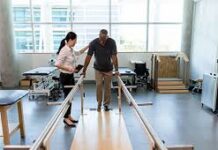Modern age is an age of machines and technologies. Advancement of equipments and techniques has not only lead to improvement of home appliances like television, fridge, computer and dish washer but also contributed to immense development in the health sector through laser therapy, artificial organ implantation and robotic surgery. Invention of robotic surgery is a monumental event in the history of medical advancement. It marks a ground-breaking change in the field of surgery. It is a marvel of science.
Whenever someone hears about robotic surgery, multitude of questions clouds one’s mind. Most are unsure about its real meaning. Patients are apprehensive and are unwilling to let a robot perform a grave surgery on them. They fear that the machine may go wrong and disrupt the procedure, leading to the death of the patients. Truthfully, a robotic surgery doesn’t function like that. In no way a humanoid robot will suddenly start acting as a doctor. It will never attend to patients on its own. Robotic surgery is just a surgical procedure duly supervised by the doctors. It may have a terrifying connotation attached to its name, but that’s wholly because it is something new and unheard of. It’s simply the fear of the unknown that makes the human being fear robotic surgery. An in depth knowledge may clarify the concept and make it less fearful to the patients across the globe.
What is a Robot?
A robot is nothing like the Monster created by Victor Frankenstein in Mary Shelley’s science fiction ‘Frankenstein.’ It is not some grotesque creature made by a scientist. It’s not fearful and destructive. It is certainly not capable of having feelings and decision-making power. Robot is also not a toy or game which children purchase from toyshops and play with. It’s not as simple as a remote-controlled device.
Robots are machines run by programs. Programmers and scientists specifically design computerised program and fit it inside a machine so as to enable it to perform a specified task. The software program makes the robot function just as a computer’s software makes a computer’s hardware like monitor, CPU and printer run according to commands given by the user. A robot is a kind of advanced machinery capable of performing tasks allotted by human beings.
A humanoid robot is a recent development in the field of Robotics. It looks like human beings in terms of stature and facial features. Unlike human being they are not capable of giving an emotion response. They analyse data and give logical solutions to problems.
Robotic Surgery
Robotic surgery is a type of minimally invasive surgery like laparoscopy where a machine, typically a robotic hand, performs the surgical procedure under the supervision of the doctors. The machine performs the operation according to the doctors’ instructions. There is hardly a scope for the machine to go wrong. Even if the machine does encounter an error in its programming, the doctors in charge have enough scope for damage control as they are physically present during the process.
Therefore, robotic surgery is not totally different from traditional surgery where the doctor operated the patient. Reassuring hand of the doctor is nearby to comfort the troubled patient even during a robotic surgery.
History
The first robot to perform surgery was the Arthrobot. It was made in 1983 by a team of experts. The group was headed by Dr. James McEwen and Geof Auchinlek. It was used in Vancouver by the orthopedic surgeon Dr Brian Day. The robot could perform leg surgery based on voice instructions. PUMA system was also used to perform robotic surgery in 1985. It performed a successful brain biopsy. Later, in 2000, Da Vinci Surgical System, another advanced robotic arm, started performing urological surgeries, hysterectomies and surgeries related to prostate cancer. In Da Vinci System a doctor controls the robotic arm from a special room attached to the operation theatre. The doctor can examine the patient’s internal organs through camera attached to the robotic hand. This system is popularly known for performing surgeries through small incision.
Robotic Surgery in India
The first robotic surgery in India was performed in 2006. Robotic prostatectomy was conducted in AIIMS, New Delhi. The earliest successful robotic surgery in a government hospital took place in Safdarjung Hospital of New Delhi. Apollo Hospitals is the only popular set up at present that provides robotic surgery to people across India.
Merits
- Robotic surgery can help doctors to perform major surgeries with accuracy.
- Recovery time of the patient is quicker as the incision or cut made during the surgery is really small.
- A robotic arm does not get tired. So, it can perform a great number of surgeries in a small span of time.
- Lack of human contact during surgery reduces the chances of infection of the patient.
Demerits
- Robotic surgery cannot be performed without the supervision of an expert doctor.
- A doctor needs special and additional training to carry out a robotic surgery.
- It is costly and is not affordable by everyone.
- No machine has 100% success rate. So, a robotic arm too can malfunction at times.
- Cost of repairing a robotic arm and maintaining it in a hospital set-up is huge.
Success Rate
Success rate of robotic surgery ranges from 94% to 100%. It’s the same as any other traditional surgery. Also, the rate of complication is lesser than the average.
With the advancement of scientific technologies robotic surgery is an option patients are likely to opt for as it involves reduced operation time and faster recovery. Aim of science has always been to make life easier for human beings. Each invention is an attempt to make human life more comfortable to lead. Robotic surgery is no exception. With increased success rate, greater accuracy and faster recovery time, robotic surgery is a life-changing scientific progress. It has given human beings a new lease of life by treating and curing diseases which were once considered incurable. In the past patients had died because certain illnesses were considered inoperable. Surgeons with their limited human capacity failed to deal with them surgically. Now, the unlimited knowledge of science and technology has opened up the avenues to treat the untreatable diseases. Therefore, robotic surgery is another advancement of science which the people have embraced in order to live a disease-free life. It has presented an opportunity to lead a healthy human life.
Authored By: Lagnajita
















